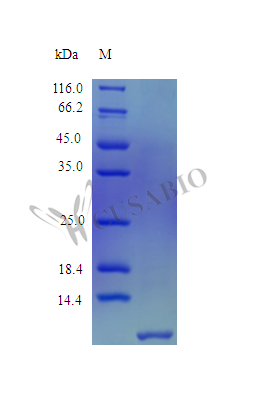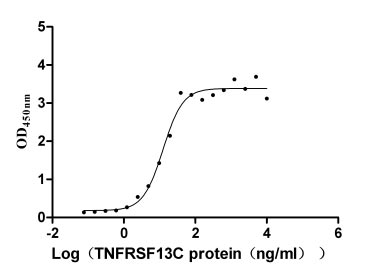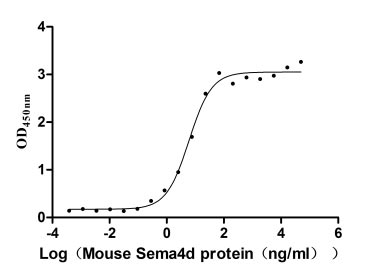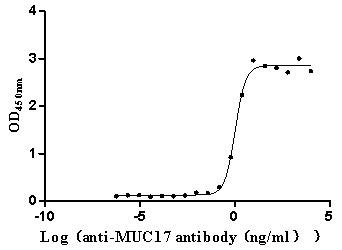Recombinant Human Beta-defensin 103 protein (DEFB103A)
In Stock产品详情
-
纯度:>98% as determined by SDS-PAGE.
-
内毒素:Less than 1.0 EU/μg as determined by LAL method.
-
生物活性:Fully biologically active when compared to standard. The ED50 as determined by anti-microbial activity against E.coli. is less than 30 μg/ml, corresponding to a specific activity of >33.3 IU/mg.
-
基因名:DEFB103A
-
Uniprot No.:
-
别名:BD 3; BD-3; BD3; beta 103; Beta defensin 103A; Beta defensin 103A precursor; Beta defensin 3; Beta-defensin 103; Beta-defensin 3; D103A_HUMAN; DEF B3; DEFB 103; DEFB 103A; DEFB 3; DEFB-3; DEFB103; DEFB103A; DEFB103B; DEFB3; Defensin; Defensin beta 103A; Defensin beta 3; Defensin like protein; Defensin-like protein; HBD 3; hBD-3; HBD3; HBP 3; HBP3; mBD3
-
种属:Homo sapiens (Human)
-
蛋白长度:Full Length of Mature Protein
-
来源:E.Coli
-
分子量:5.2 kDa
-
表达区域:23-67aa
-
氨基酸序列GIINTLQKYY CRVRGGRCAV LSCLPKEEQI GKCSTRGRKC CRRKK
-
蛋白标签:Tag-Free
-
产品提供形式:Liquid or Lyophilized powder
Note: We will preferentially ship the format that we have in stock, however, if you have any special requirement for the format, please remark your requirement when placing the order, we will prepare according to your demand. -
缓冲液:0.2 μm filtered 20 mM PB, pH 7.4, 130 mM NaCl ,lyophilized
-
储存条件:Store at -20°C/-80°C upon receipt, aliquoting is necessary for mutiple use. Avoid repeated freeze-thaw cycles.
-
保质期:The shelf life is related to many factors, storage state, buffer ingredients, storage temperature and the stability of the protein itself.
Generally, the shelf life of liquid form is 6 months at -20°C/-80°C. The shelf life of lyophilized form is 12 months at -20°C/-80°C. -
货期:5-10 business days
-
Datasheet & COA:Please contact us to get it.
相关产品
靶点详情
-
功能:Exhibits antimicrobial activity against Gram-positive bacteria S.aureus and S.pyogenes, Gram-negative bacteria P.aeruginosa and E.coli and the yeast C.albicans. Kills multiresistant S.aureus and vancomycin-resistant E.faecium. No significant hemolytic activity was observed.
-
基因功能参考文献:
- this study shows that hBD3 amplifies the response to bacterial DNA in both mouse and human immune cells in a TLR9-dependent manner PMID: 28102569
- the role of DEFB103 gene copy number variation (CNV) in ankylosing spondylitis (AS) susceptibility, was investigated. PMID: 26224324
- It may be concluded hepatitis B virus up-regulates HBD-3 and A3G expression in vivo and in vitro in placental trophoblast and lack of this up-regulation is possibly associated with intrauterine transmission of hepatitis B. PMID: 25196417
- The encoded peptide displays antimicrobial activity against S. aureus and E. faecium. PMID: 11085990
- these observations suggest that there may be an interracial difference in DEFB4/103A copy numbers between admixed populations and a relationship between DEFB1 single nucleotide polymorphisms and DEFB4/103A copy number variation PMID: 23194186
- Human beta-defensin 3 peptide is increased and redistributed in Crohn's ileitis PMID: 23511030
- study demonstrates that HBD2 and 3 activate plasmacytoid dendritic cells by enhancing the intracellular uptake of CpG and self DNA and promote DNA-induced IFN-alpha production in a TLR9-dependent manner PMID: 23776172
- Mapping of key residues in the interaction between human Beta-defensin 3 and CXCR4 reveals key defensin motifs involved in protein binding. PMID: 23659571
- These results suggest an important role for hBD3 in inducing dendritic cell activation, migration, and polarization. PMID: 22951718
- Using a large, unique cohort of pediatric CA-SAB, this study found no significant association between DEFB1 genetic variation or DEFB4/DEFB103 gene copy number and susceptibility for Staphylococcus aureus bacteremia PMID: 22384213
- Human beta-defensin 3 exhibits further functions than antimicrobial peptide activity in cultured bone cells, including stimulation of proliferation and differentiation. PMID: 21520074
- Data show that high-glucose conditions inhibited the BD3 expression of epidermal keratinocytes. PMID: 21442129
- hBD-1 might function as a tumor suppressor gene in oral squamous cell carcinoma, while hBD-2 and -3 might be protooncogenes. PMID: 21280982
- extraplacental membranes can react differentialy to the arrival of E. coli, secreting HBD2 and HBD3 mainly in the choriodecidua region. PMID: 21122132
- PPARgamma regulates the 1,25D-induced hBD-3 and cathelicidin expression in keratinocytes through the regulation of AP-1 and p38 activity. PMID: 20970965
- hBD3 represents a novel NF-kappaB-regulated mediator of CCR7 expression and anti-apoptotic pathways. PMID: 21071608
- Inducibility of HBD3 influences the severity of Gram-positive skin infection in humans in vivo. PMID: 20404083
- Data show that beta-defensin cluster (DEFB4, DEFB103 and DEFB104) varied between 2 and 9 copies per genome, and high copy numbers (>4) were underrepresented among patients, suggesting that increased copy numbers could protect from CD. PMID: 20483368
- Human pulmonary cells produce hBD-3 upon L. pneumophila infection via a TLR-JNK-AP-1-dependent pathway which may contribute to an efficient innate immune defense. PMID: 20615218
- The beta-defensin antimicrobial peptides hBD1, hBD2 and hBD3 were expressed by immature dendritic cells as well as gingival epithelial cells. PMID: 20618959
显示更多
收起更多
-
亚细胞定位:Secreted.
-
蛋白家族:Beta-defensin family
-
组织特异性:Highly expressed in skin and tonsils, and to a lesser extent in trachea, uterus, kidney, thymus, adenoid, pharynx and tongue. Low expression in salivary gland, bone marrow, colon, stomach, polyp and larynx. No expression in small intestine.
-
数据库链接:
HGNC: 15967
OMIM: 606611
KEGG: hsa:414325
STRING: 9606.ENSP00000324633
UniGene: Hs.283082
Most popular with customers
-
Recombinant Human Tumor necrosis factor ligand superfamily member 14 (TNFSF14), partial (Active)
Express system: Mammalian cell
Species: Homo sapiens (Human)
-
Express system: Mammalian cell
Species: Homo sapiens (Human)
-
Recombinant Mouse Semaphorin-4D (Sema4d), partial (Active)
Express system: Mammalian cell
Species: Mus musculus (Mouse)
-
Recombinant Macaca mulatta Microtubule-associated protein tau (MAPT) (Active)
Express system: Mammalian cell
Species: Macaca mulatta (Rhesus macaque)
-
Express system: Mammalian cell
Species: Homo sapiens (Human)
-
Express system: Mammalian cell
Species: Macaca fascicularis (Crab-eating macaque) (Cynomolgus monkey)
-
Recombinant Human Mucin-17 (MUC17), partial (Active)
Express system: Mammalian cell
Species: Homo sapiens (Human)
-
Recombinant Human Oncostatin-M (OSM), partial (Active)
Express system: Mammalian cell
Species: Homo sapiens (Human)





















